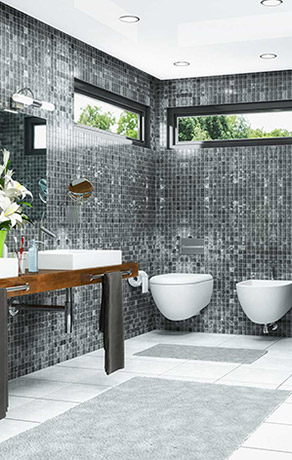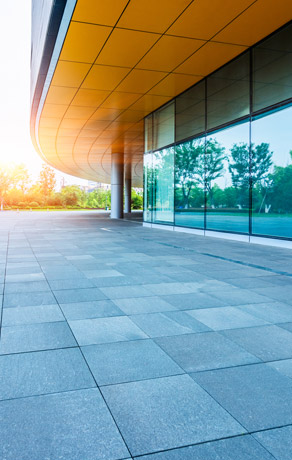Natural stone is beautiful and a gift from the ground. Once installed, it elevates your space to pure luxury. However, even stone is not immune to wear and tear over time. Daily use, spills, and exposure to the elements can lead to chips, cracks, stains, and dullness, diminishing its beauty. As expert stone masons, we specialize in stone maintenance and restoration, ensuring your surfaces always look their best. Whether it’s fixing chips or cracks on countertops, re-polishing or re-honing benchtops and tiles, or removing stains and etching caused by wine, sauces, oil, or coffee, we have the skills and tools to restore your stone to its original brilliance.
We use state-of-the-art restoration techniques and equipment to breathe new life into worn or damaged stone. From revitalizing dull surfaces to achieving a mirror-like polish, our team meticulously restores stone without compromising its integrity. Whether your stone needs deep cleaning, sealing, or resurfacing, we approach each project with precision and care. We work with all types of natural stone, including marble, granite, limestone, and travertine, and tailor our services to suit the unique characteristics of each material. Our goal is to preserve the longevity and beauty of your stone, ensuring it continues to add value and elegance to your home or commercial space.
When we work with a client, we aim to build a lifelong relationship by offering ongoing maintenance services and packages designed to keep your stone surfaces looking brand new. We understand that natural stone is an investment, and we’re here to help protect that investment with routine care and expert restoration when needed. Our commitment to quality craftsmanship and customer satisfaction means you can trust us to handle your stone with the utmost professionalism and attention to detail. Whether it’s periodic polishing, stain removal, or structural repairs, we provide solutions that ensure your stone remains a statement of luxury and elegance for years to come.
Clean & Clear

GET TO KNOW YOUR STONE
The first step in proper stone care and maintenance is to understand your stone’s geological classification and composition. this information will help you to identify what cleaning products to use and how best to care for your natural stone.
Natural stone is categorized into three basic geological classifications by their respective formation processes: Sedimentary, Metamorphic and igneous. Additionally, stones in each category can be either Calcareous or Siliceous.
Calcareous stone is composed mainly of calcium carbonate, a chemical compound commonly found in natural stone, shells and pearls. Calcium Carbonate is sensitive to acidic solutions so mild, non-acidic cleaners are recommended.
Siliceous stone, as the term implies, is one composed primarily of silicates, such as quartz, feldspar, mica, etc. as such, a siliceous stone is generally resistant to most acids found in kitchen settings, although acidic cleaners are still not recommended, as these stones may contain trace levels of minerals that are acid sensitive.
The following chart will be a helpful guide:
EASY CARE TIPS

Coasters
Use coasters under all glasses, particularly those containing alcohol or citrus juices.

Trivets
While many stones can withstand heat, the use of trivets or mats is recommended.

Dust Mopping
Dust mop interior floors frequently using a clean non-treated dry dust mop. Sand, dirt and grit are abrasive and can damage natural stone.

Mats/Rugs
Mats or area rugs inside and outside an entrance will help to minimize the sand, dirt and grit that may scratch the stone floor. Be sure that the underside of the mat or rug is a slip resistant surface.

Vacuum Cleaners
If used, be sure the metal or plastic attachments or the wheels are not worn as they can scratch the surface of some stones.

Spills
Blot the spill with a paper towel immediately. Don't wipe the area, it will spread the spill. Flush the area with water and mild soap and rinse several times. Dry the area thoroughly with a soft cloth. Repeat as necessary.
CLEANING
Clean stone surfaces with a neutral cleaner, stone soap, or a mild liquid dishwashing detergent and warm water. Similar to any item cleaned in your home, an excessive concentration of cleaner or soap may leave a film and cause streaks. Follow manufacturer recommendations.
Use a clean rag mop on floors and a soft cloth for other surfaces for best results. Rinse the surface thoroughly after washing with the soap solution and dry with a soft cloth.
Change the rinse water frequently. In the bath or other wet areas, soap scum can be minimized by using a squeegee after each use. To remove soap scum, use a non-acidic soap scum remover or a solution of ammonia and water (about 1/2 cup ammonia to a gallon of water).
Frequent or over-use of an ammonia solution may eventually dull the surface of some stone types. In outdoor pool, patio or hot tub areas, flush with clear water and use mild bleach solution to remove algae or moss.

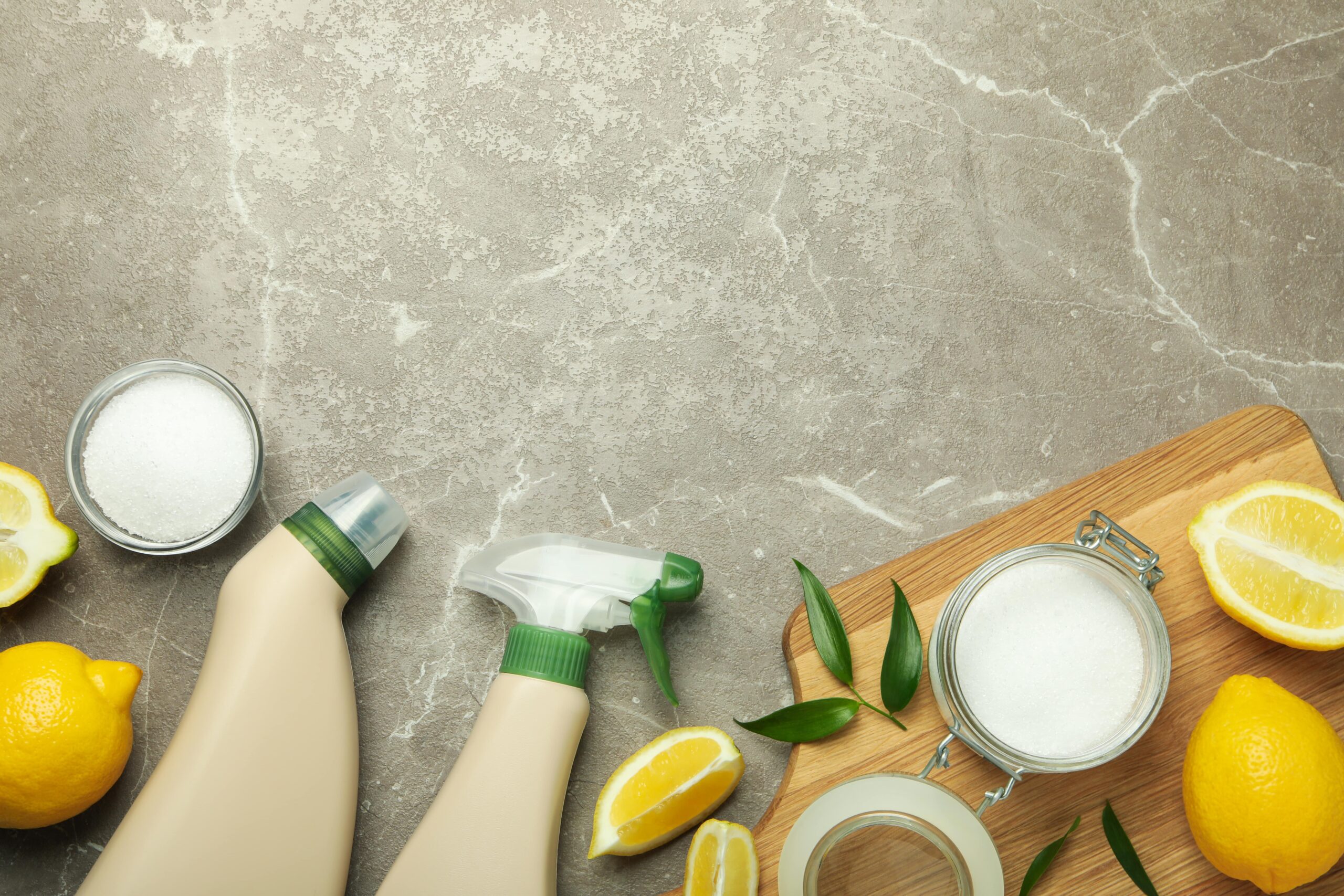
CLEANING PRODUCTS
Many suppliers offer products used for stone cleaning. Products containing lemon, vinegar or other acids may dull or etch calcareous stones.
Scouring powders or creams often contain abrasives that may scratch certain stones. Many commercially available rust removers (laundry rust stain removers, toilet bowl cleaners) contain trace levels of hydrofluoric acid (HF). This acid attacks silicates in addition to other minerals. All stones, including granite and quartzite, will be attacked if exposed to HF.
Do not mix ammonia and bleach. This combination creates a toxic and lethal gas
SEALING
Sealing is a common step taken on some stones as an extra precaution against staining. In fact, the sealing products used in the stone industry are “impregnators” which do not actually seal the stone, but more correctly act as a repellent rather than a sealer.
Sealing does not make the stone stain proof, rather it makes the stone more stain resistant. When consulting with your stone supplier, you may find that many stones do not require sealing. However, applying an impregnating sealer is a common practice.
When considering sealing, remember that sealing the stone does not make the stone stain proof, it makes it more resistant to staining. If a sealer is applied in a food preparation area, be sure that it is non-toxic and safe for use.
Consult with your supplier or sealing manufacturer specific to the type of sealer and frequency of use recommended.
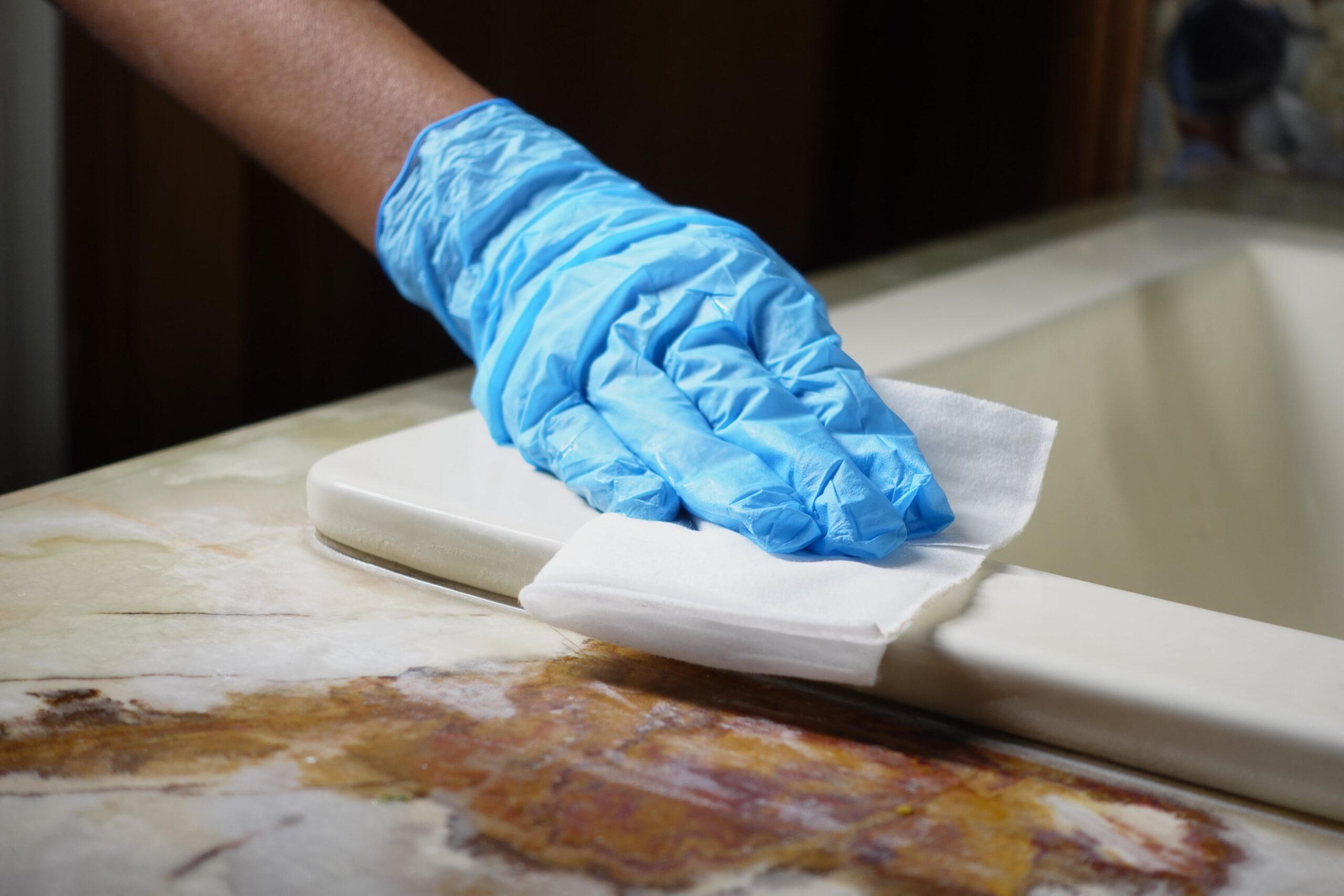
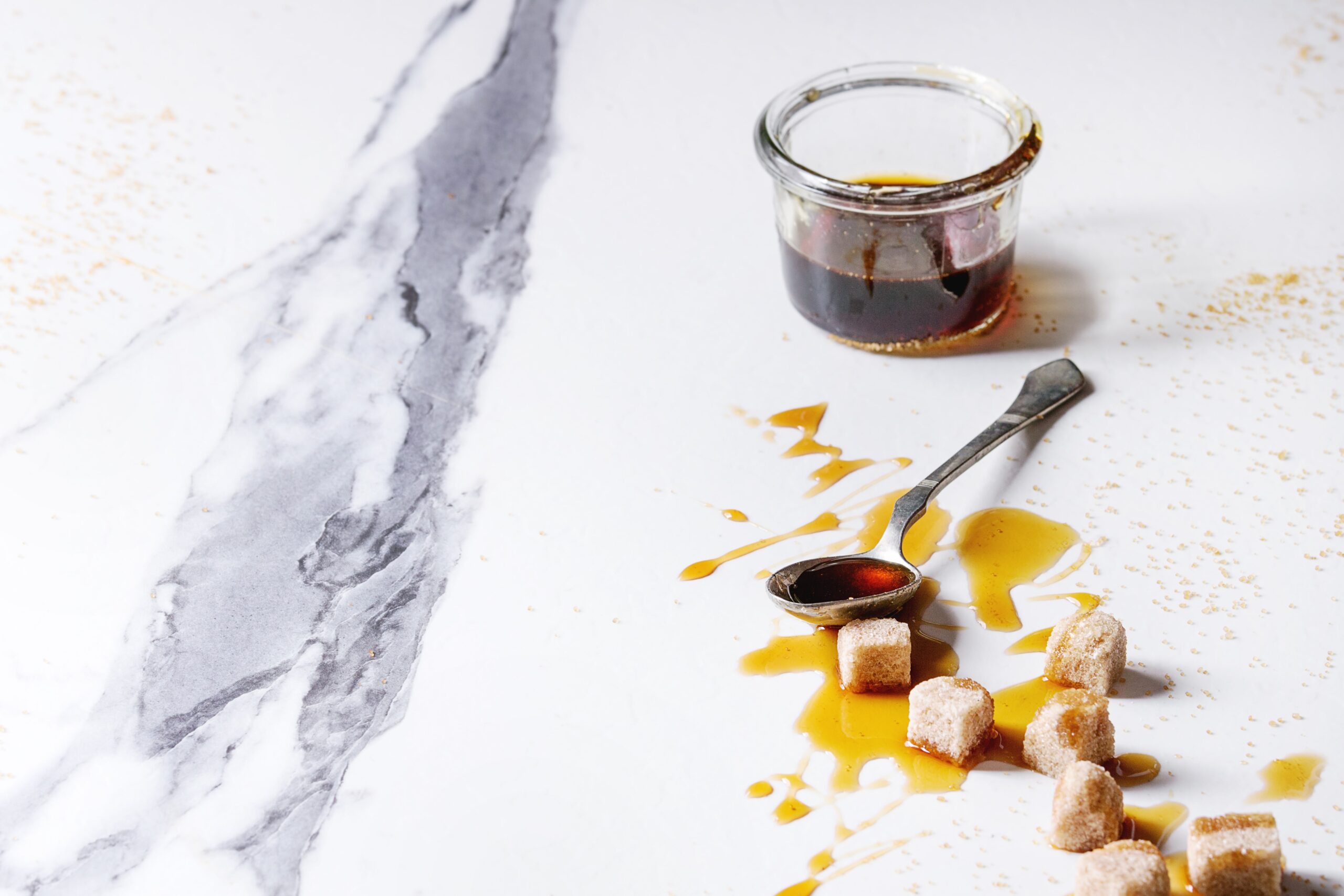
STAIN IDENTIFICATION TIPS
Identifying the type of stain on the stone surface is the key to removing it. Stains can be
oil based, organic, metallic, biological, ink based, paint based, acid based. If you don’t
know what caused the stain, consider likely staining agents that may have been
present. Here are some questions you consider:
– Where is the stain located?
– Is it near a plant, a food service area, an area where cosmetics are used?
– What color is it?
– What is the shape or pattern?
– What occurs in the area around the stain?
– Stain Removal Steps:
Surface stains can often be removed by cleaning with an appropriate cleaning product or household chemical.
WHAT TYPE OF STAIN IS IT?
The following sections describe the types of stains you may have to deal with and the appropriate household chemicals to use and how to prepare and apply a poultice to remove the stain.

Oil-based
(grease, plumbers' putty, tar, cooking oil, milk, cosmetics) An oil-based stain will darken the stone and normally must be chemically dissolved so the source of the stain can be flushed or rinsed away. Clean gently with a soft, liquid cleanser with one of the following: household detergent, mineral spirits, or acetone.

Organic
(coffee, tea, wine, fruit, tobacco, paper, food, urine, leaves, bark, bird droppings) May cause a pinkish-brown stain and may disappear after the source of the stain has been removed. Outdoors, with the sources removed, sun and rain action will generally bleach out the stains. Indoors, clean with 12% hydrogen peroxide (hair bleaching strength) and a few drops of ammonia.

Biological
(algae, mildew, lichens, moss, fungi) Clean with diluted cleaning solution. Use a 1/2 cup of any of the following: ammonia, bleach, or hydrogen peroxide and a gallon of water. Reminder: do not mix bleach and ammonia.

Ink
(magic marker, pen, ink) On light colored stones, clean with bleach or hydrogen peroxide. On dark colored stones, clean with lacquer thinner or acetone.

Water Spots & Rings
(surface accumulation of hard water) Buff with dry 0000 steel wool.

Fire & Smoke Damage
Older stones and smoke or fire-stained fireplaces may require a thorough cleaning. When the smoke is removed, there may also be some etching (due to carbonic & other acids in smoke). Commercially available "smoke removers" may save time and effort.

Etch Marks
(caused by acids left on the surface of the stone) Some materials will etch the finish but not leave a stain. Others will both etch and stain. Contact your stone dealer or call a professional stone restorer for refinishing or repolishing etched areas.

Scratches & Nicks
Slight surface scratches may be buffed with dry 0000 steel wool. Deeper scratches and nicks in the surface of the stone should be repaired and repolished by a professional.

Using a Poultice
Go to www.marble-institute.com/consumers/poultices/ for more information, or call a stone professional (recommended).

Metal
(iron, rust, copper, bronze) Iron or rust stains are orange to brown in color and follow the shape of the staining object such as nails, bolts, screws, cans, flower pots, metal furniture. Copper and bronze stains appear as green or muddy-brown and result from the action of moisture on nearby or embedded bronze, copper or brass items. Metal stains must be removed with a poultice. (See website on Using a Poultice – www.marble-institute.com/consumers/poultices/. Deep-seated, rusty stains are extremely difficult to remove and the stone may be permanently stained.

Paint
Small amounts can be removed with lacquer thinner or scraped off carefully with a razor blade. Heavy paint coverage should be removed only with a commercial "heavy liquid" paint stripper available from hardware stores and paint centers. These strippers normally contain caustic soda or lye. Do not use acids or flame tools to strip paint from stone. Paint strippers can etch the surface of the stone; repolishing may be necessary. Follow the manufacturer's directions for use of these products, and flush the area thoroughly with clean water. Protect yourself with rubber gloves and eye protection, and work in a well-ventilated area. Use only wood or plastic scrapers for removing the sludge and curdled paint. Normally, latex and acrylic paints will not cause staining. Oil-based paints, linseed oil, putty, caulks and sealants may cause oily stains. Refer to the section on oil-based stains.

Efflorescence
(a white powder that may appear on the surface of the stone) It is caused by the deposition of mineral salts carried by water from below the surface of the stone. When the water evaporates, it leaves the powdery substance. If the installation is new, dust mop or vacuum the powder. You may have to do this several times as the stone dries out. Do not use water to remove the powder; it will only temporarily disappear. If the problem persists, contact your installer to help identify and remove the cause of the moisture.
TOP SERVICES
Our Specializations
OUR PROCESS
See How It Works
OUR SERVICES
Our Specializations
Architects
Consectetur Lorem ipsum dolor sit ame consectetur adipisicing elit, sed do eiusmod tempor dolor sit ame consectetur.
Home Plan
Consectetur Lorem ipsum dolor sit ame consectetur adipisicing elit, sed do eiusmod tempor dolor sit ame consectetur.
Road
Consectetur Lorem ipsum dolor sit ame consectetur adipisicing elit, sed do eiusmod tempor dolor sit ame consectetur.
Constructions
Consectetur Lorem ipsum dolor sit ame consectetur adipisicing elit, sed do eiusmod tempor dolor sit ame consectetur.
Home For Sell
Consectetur Lorem ipsum dolor sit ame consectetur adipisicing elit, sed do eiusmod tempor dolor sit ame consectetur.
Development
Consectetur Lorem ipsum dolor sit ame consectetur adipisicing elit, sed do eiusmod tempor dolor sit ame consectetur.
26k+
Happy Customers
700+
Projects Completed
15+
Years of Experience
5+
Award Winner
Our Testimonial
What Client Says



Eiusmod tempor incididunt ut labore et dolore magna aliqua. Ut enim ad minim veniam, quis nostrud exercitation ullamco laboris nisi ut aliquip ex ea commodo consequat. Duis aute irure dolor in reprehenderit in volupte velit ess cillum dolore eu fugiat nulla pariatur. Excepteur sint occaecat cupidatat non proident, sunt in culpa qui officia deserunt mollit anim id est laborum.
Sonia Roberts- Ui Designer
Eiusmod tempor incididunt ut labore et dolore magna aliqua. Ut enim ad minim veniam, quis nostrud exercitation ullamco laboris nisi ut aliquip ex ea commodo consequat. Duis aute irure dolor in reprehenderit in volupte velit ess cillum dolore eu fugiat nulla pariatur. Excepteur sint occaecat cupidatat non proident, sunt in culpa qui officia deserunt mollit anim id est laborum.
Sophie Pullman- UX Designer
Eiusmod tempor incididunt ut labore et dolore magna aliqua. Ut enim ad minim veniam, quis nostrud exercitation ullamco laboris nisi ut aliquip ex ea commodo consequat. Duis aute irure dolor in reprehenderit in volupte velit ess cillum dolore eu fugiat nulla pariatur. Excepteur sint occaecat cupidatat non proident, sunt in culpa qui officia deserunt mollit anim id est laborum.


